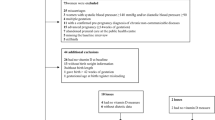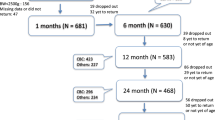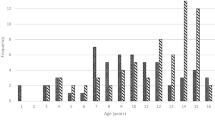Abstract
Background/objectives:
Low vitamin D status during pregnancy may be associated with infant skeletal growth. However, evidence on the longer-term effect is limited. This study aims to assess the association between maternal vitamin D status in early pregnancy and markers of linear growth (height, leg length and relative leg length) of the child at age 5–6 years.
Subjects/methods:
A subsample of data from the Amsterdam Born Children and Development (ABCD) study was used. Ethnic Dutch pregnant women and their children (n=1208) were included. Maternal serum vitamin D level was determined at first antenatal visit (median 13 weeks, interquartile range: 12–14). We investigated the association of maternal vitamin D, corrected for season, with height, leg length and relative leg length at age 5–6 years.
Results:
Linear regression analyses showed no significant association between maternal vitamin D levels (nmol/l) and height (cm) (B=−0.006; P=0.205), leg length (cm) (B=−0.002, P=0.540) or relative leg length (%) (B=0.001; P=0.579). Adjustment for potential confounders (parental heights, maternal educational level, alcohol use during pregnancy, child sex, child age at measurement and child screen time) did not change these results.
Conclusions:
Maternal vitamin D level was not associated with early linear growth in children. Other factors, such as parental height, appear to be more important.
This is a preview of subscription content, access via your institution
Access options
Subscribe to this journal
Receive 12 print issues and online access
$259.00 per year
only $21.58 per issue
Buy this article
- Purchase on Springer Link
- Instant access to full article PDF
Prices may be subject to local taxes which are calculated during checkout


Similar content being viewed by others
References
Holick MF . Sunlight and vitamin D for bone health and prevention of autoimmune diseases, cancers, and cardiovascular disease. Am J Clin Nutr 2004; 80: 1678S–1688S.
Webb AR . Who, what, where and when—influences on cutaneous vitamin D synthesis. Prog Biophys Mol Biol 2006; 92: 17–25.
Hollick MF, Chen TC . Vitamin D deficiency: a worldwide problem with health consequences. Am J Clin Nutr 2008; 87 (Suppl), 1080S–1086S.
Hollis BW, Wagner CL . Vitamin D deficiency during pregnancy: an ongoing epidemic. Am J Clin Nutr 2006; 84: 273.
Schroth RJ, Lavelle CL, Moffatt ME . Review of vitamin D deficiency during pregnancy: who is affected? Int J Circumpolar Health 2005; 64: 112–120.
Pawley N, Bishop NJ . Prenatal and infant predictors of bone health: the influence of vitamin D. Am J Clin Nutr 2004; 80 (Suppl 6), 1748S–1751S.
Viljakainen HT, Saarnio E, Hytinantti T, Miettinen M, Surcel H, Mäkitie O et al. Maternal vitamin D status determines bone variables in the newborn. J Clin Endocrinol Metab 2010; 95: 1749–1757.
Javaid MK, Crozier SR, Harvey NC, Gale CR, Dennison EM, Boucher BJ et al. Maternal vitamin D status during pregnancy and childhood bone mass at age 9 years: a longitudinal study. Lancet 2006; 367: 36–43.
Marya RK, Rathee S, Dua V, Sangwan K . Effect of vitamin D supplementation during pregnancy on foetal growth. Indian J Med Res 1988; 88: 488–492.
Morley R, Carlin JB, Pasco JA, Wark JD . Maternal 25-hydroxyvitamin D and parathyroid hormone concentrations and offspring birth size. J Clin Endocrinol Metab 2006; 91: 906–912.
Brooke OG, Butters F, Wood C . Intrauterine vitamin D nutrition and postnatal growth in Asian infants. Br Med J 1981; 283: 1024.
Leffelaar ER, Vrijkotte TG, van Eijsden M . Maternal early pregnancy vitamin D status in relation to fetal and neonatal growth: results of the multi-ethnic Amsterdam Born Children and their Development cohort. Br J Nutr 2010; 104: 108–117.
Brunvand L, Quigstad E, Urdal P, Haug E . Vitamin D deficiency and fetal growth. Early Hum Dev 1996; 45: 27–33.
Farrant HJ, Krishnaveni GV, Hill JC, Boucher BJ, Fisher DJ, Noonan K et al. Vitamin D insufficiency is common in Indian mothers but is not associated with gestational diabetes or variation in newborn size. Eur J Clin Nutr 2009; 63: 646–652.
Prentice A, Jarjou LM, Goldberg GR, Bennett J, Cole TJ, Schoenmakers I . Maternal plasma 25-hydroxyvitamin D concentration and birthweight, growth and bone mineral accretion of Gambian infants. Acta Paediatr 2009; 98: 1360–1362.
Mahon P, Harvey N, Crozier S, Inskip H, Robinson S, Arden N et al. Low maternal vitamin D status and fetal bone development: cohort study. J Bone Miner Res 2010; 25: 14–19.
Viljakainen HT, Korhonen T, Hytinantti T, Laitinen EK, Andersson S, Mäkitie O et al. Maternal vitamin D status affects bone growth in early childhood—a prospective cohort study. Osteoporos Int 2011; 22: 883–891.
Leary S, Ness A, Emmett P, Davey Smith G, ALSPAC Study Team. Maternal diet in pregnancy and offspring height, sitting height, and leg length. J Epidemiol Community Health 2005; 59: 467–472.
Gale CR, Robinson SM, Harvey NC, Javaid MK, Jiang B, Martyn CN et al. Maternal vitamin D status during pregnancy and child outcomes. Eur J Clin Nutr 2008; 62: 68–77.
Krishnaveni GV, Veena SR, Winder NR, Hill JC, Noonan K, Boucher BJ et al. Maternal vitamin D status during pregnancy and body composition and cardiovascular risk markers in Indian children: the Mysore Parthenon Study. Am J Clin Nutr 2011; 93: 628–635.
Gunnell D . Commentary: Can adult anthropometry be used as a ‘biomarker’ for prenatal and childhood exposures? Int J Epidemiol 2002; 31: 390–394.
Gunnel D, Okasha M, Smith GD, Oliver SE, Sandhu J, Holly JM . Height, leg length, and cancer risk: a systematic review. Epidemiol Rev 2001; 23: 313–342.
Smith GD, Greenwood R, Gunnell D, Sweetnam P, Yarnell J, Elwood P . Leg length, insulin resistance, and coronary heart disease risk: the Caerphilly Study. J Epidemiol Community Health 2001; 55: 867–872.
Lawlor DA, Taylor M, Davey Smith G, Gunnell D, Ebrahim S . Associations of components of adult height with coronary heart disease in postmenopausal women: the British Women’s Heart and Health Study. Heart 2004; 90: 745–749.
Bogin B, Varela-Silva MI . Leg length, body proportion, and health: a review with a note on beauty. Int J Environ Res Public Health 2010; 7: 1047–1075.
Barker DJ, Godfrey KM . Maternal nutrition, fetal programming and adult chronic disease. In: Gibney MJ, Margetts BM, Kearney JM et al Public Health Nutrition. Blackwell Science: Oxford. pp. 302–316, 2004.
van Eijsden M, Vrijkotte TG, Gemke RJ, van der Wal MF . Cohort profile: The Amsterdam Born Children and their Development (ABCD) Study. Int J Epidemiol 2011; 40: 1176–1186.
Dutman AE, Stafleu A, Kruizinga A, Brants HA, Westerterp KR, Kistemaker C et al. Validation of an FFQ and options for data processing using the doubly labelled water method in children. Public Health Nutr 2011; 14: 410–417.
Hof MH, van Dijk AE, van Eijsden M, Vrijkotte TG, Zwinderman AH . Multi-ethnic comparison of reference growth charts for infants 0-3 years from the Dutch ABCD cohort. Ann Hum Biol 2011; 38: 544–555.
de Beer M, van Eijsden M, Vrijkotte TG, Gemke RJ . Early growth patterns and cardiometabolic function at the age of 5 in a multiethnic birth cohort: the ABCD study. BMC Pediatr 2009; 9: 23.
Ocké MC, van Rossum CT, Fransen HP, Buurma EM, de Boer EJ, Brants HAM et al. Dutch National Food Consumption Survey—Young Children 2005/2006. National Institute for Public Health and the Environment (RIVM): Bilthoven, 2008.
Allison PD . Missing Data. Sage Publications: Thousand Oaks, CA, 2001.
Chung M, Balk EM, Brendel M, Ip S, Lau J, Lee J et al. Vitamin D and calcium: a systematic review of health outcomes. Evid Rep Technol Assess 2009; 183: 1–420.
Brooke OG, Brown IR, Bone CD, Carter ND, Cleeve HJ, Maxwell JD et al. Vitamin D supplements in pregnant Asian women: effects on calcium status and fetal growth. Br Med J 1980; 280: 751–754.
Diffey BL . Modelling vitamin D status due to oral intake and sun exposure in an adult British population. Br J Nutr 2013; 23: 1–9.
Kovacs CS . Vitamin D in pregnancy and lactation: maternal, fetal, and neonatal outcomes from human and animal studies. Am J Clin Nutr 2008; 88: 520S–528S.
Lampl M, Jeanty P . Timing is everything: a reconsideration of fetal growth velocity patterns identifies the importance of individual and sex differences. Am J Hum Biol 2003; 15: 667–680.
Health Council of The Netherlands. Towards an Adequate Intake of Vitamin D (in Dutch). Health Council of The Netherlands: The Hague, 2008.
Hindmarsh PC, Geary MP, Rodeck CH, Kingdom JC, Cole TJ . Factors predicting ante- and postnatal growth. Pediatr Res 2008; 63: 99–102.
Silventoinen K, Pietiläinen KH, Tynelius P, Sørensen TI, Kaprio J, Rasmussen F . Genetic regulation of growth from birth to 18 years of age: the Swedish Young Male Twins Study. Am J Hum Biol 2008; 20: 292–298.
Health Council of the Netherlands. Dietary Reference Intakes: Calcium, Vitamin D, Thiamin, Riboflavin, Niacin, Pantothenic Acid, and Biotin (in Dutch). Health Council of the Netherlands: The Hague, 2002.
Brandenbarg J, Vrijkotte TG, Goedhart G, van Eijsden M . Maternal early pregnancy vitamin D status is associated with maternal depressive symptoms in the Amsterdam Born Children and Their Development cohort. Psychosom Med 2012; 74: 751–757.
Morley R, Carlin JB, Pasco JA, Wark JD, Ponsonby AL . Maternal 25-hydroxyvitamin D concentration and offspring birth size: effect modification by infant VDR genotype. Eur J Clin Nutr 2009; 63: 802–804.
Leary S, Davey Smith G, Ness A . Smoking during pregnancy and components of stature in offspring. Am J Hum Biol 2006; 18: 502–512.
Roche AF, Shumei SS . Human Growth: Assessment and Interpretation. Cambridge University Press: Cambridge, 2003.
Silva LM, van Rossem L, Jansen PW, Hokken-Koelega AC, Moll HA, Hofman A et al. Children of low socioeconomic status show accelerated linear growth in early childhood; results from the Generation R study. PLOS One 2012; 7: e37356.
Mulligan ML, Felton SK, Riek AE, Bernal-Mizrachi C . Implications of vitamin D deficiency in pregnancy and lactation. Am J Obstet Gynecol 2010; 202: 429 e1-429.e9.
Acknowledgements
We are grateful to all the participating hospitals, obstetric clinics and general practitioners for their assistance in implementing the ABCD study and thank all of the women who participated, for their cooperation. We like to thank Dr Wim Busschers, statistician at the AMC Department of Public Health, for his help with the statistical figures. The ABCD study was supported, in part, by the Netherlands Organisation for Health Research and Development (ZonMw) in the Hague, the Public Health Service and Municipal Council of Amsterdam, and the Academic Medical Center in Amsterdam, The Netherlands. The National Institute for Public Health and the Environment co-financed the vitamin D analyses.
Author information
Authors and Affiliations
Corresponding author
Ethics declarations
Competing interests
The authors declare no conflict of interest.
Rights and permissions
About this article
Cite this article
van Eijsden, M., Snijder, M., Brouwer, I. et al. Maternal early-pregnancy vitamin D status in relation to linear growth at the age of 5–6 years: results of the ABCD cohort. Eur J Clin Nutr 67, 972–977 (2013). https://doi.org/10.1038/ejcn.2013.106
Received:
Revised:
Accepted:
Published:
Issue Date:
DOI: https://doi.org/10.1038/ejcn.2013.106
Keywords
This article is cited by
-
“You are my sunshine, my only sunshine”: maternal vitamin D status and supplementation in pregnancy and their effect on neonatal and childhood outcomes
Hormones (2023)
-
Fetal vitamin D concentration and growth, adiposity and neurodevelopment during infancy
European Journal of Clinical Nutrition (2018)
-
An examination of whether associations exist between maternal and neonatal 25OHD and infant size and adiposity at birth, 6–9 months and 2–2.5 years of age – a longitudinal observational study from the ROLO study
BMC Nutrition (2017)



